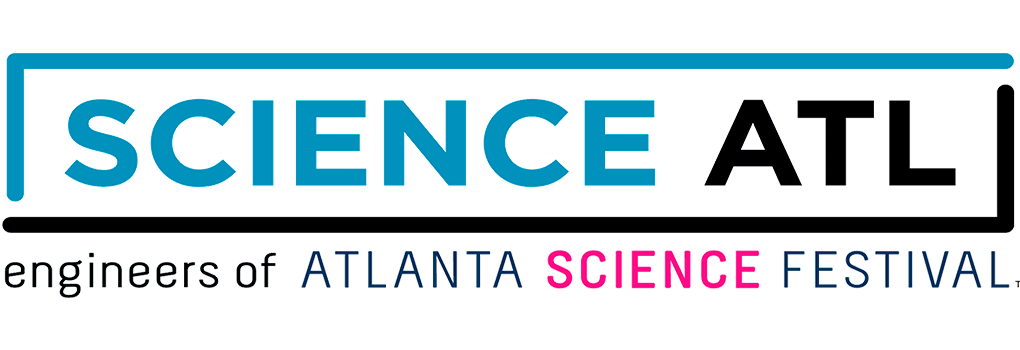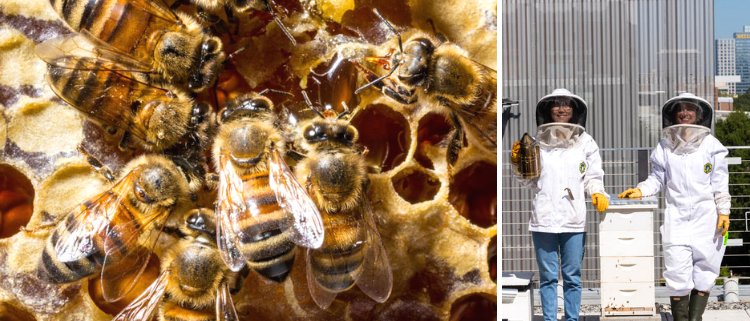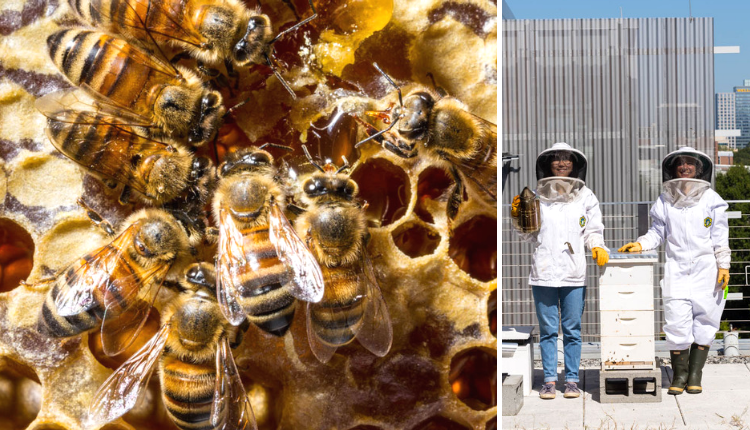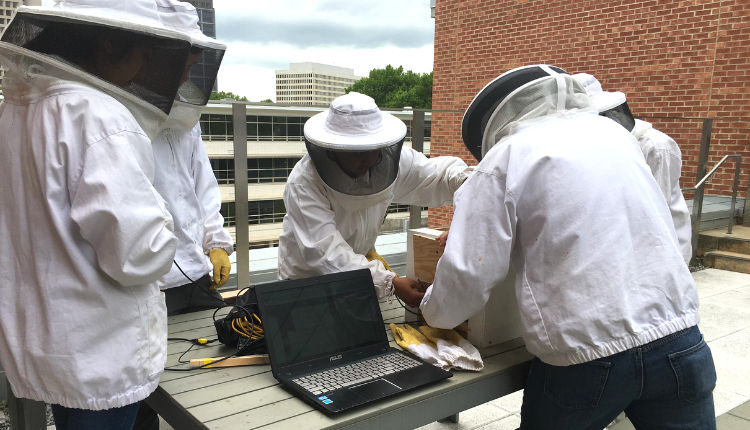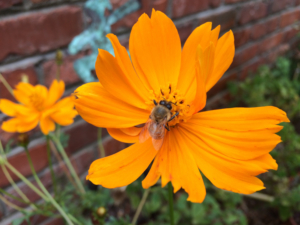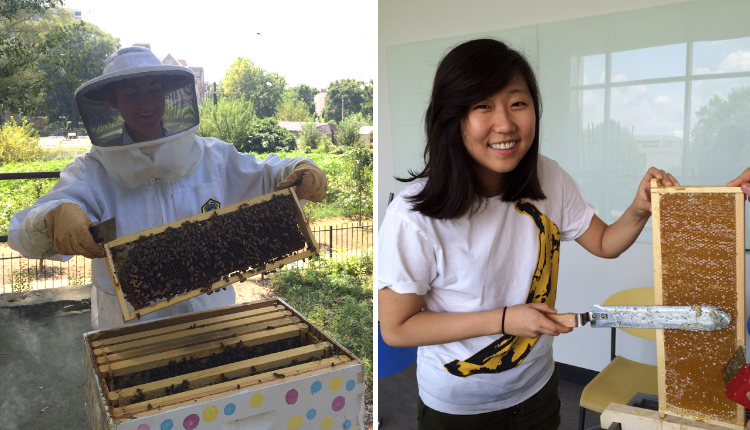The Science Behind Honey with Urban Honey Bee Project
By: Brielle James
Photos provided by Jennifer Leavey
On the roof of the Georgia Institute of Technology’s Clough Undergraduate Learning Commons sit four waist-high stacks of white boxes. For about 200,000 Western honey bees (Apis mellifera), these boxes are considered home. Together, the boxes (known as supers or hive boxes, each containing numerous wooden frames for the bees to build their honeycomb on) form four beehives belonging to the Georgia Tech Urban Honey Bee Project.
Since the Spring of 2013, the Urban Honey Bee Project, led by Dr. Jennifer Leavey, has maintained anywhere between two and seven hives on the roof of this building. “Once I brought bees to campus,” Dr. Leavey said, “people were really interested in using them for research and learning how to keep bees.” Western honey bees, which originated in eastern Europe, are the most widely managed bees in the world, supplying honey for a worldwide commercial market. How they do this is driven mainly by their biology, allowing them to work together as pint-sized chemists to create the honey we all love.
TEAMWORK
Survival of the colony and honey production requires a group effort from all of the bees in the hive. In every honey bee hive, Dr. Leavey explained, there are 3 types of bees: the queen, worker bees, and drones. Queen bees are responsible for laying and fertilizing eggs (known as brood) to grow the colony.
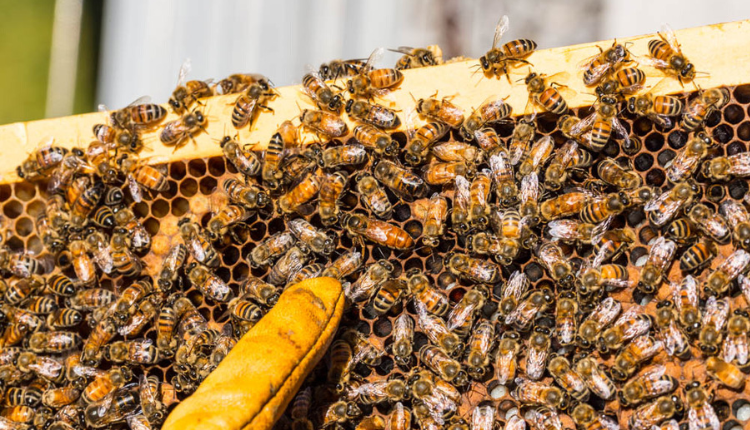
Pointing out the queen bee in the hive
Worker bees, which are all nonreproducing female bees, make up the majority of the colony. “Worker bees do different jobs at different ages,” Dr. Leavey says. Young bees work inside of the hive as “nurse” bees to eggs and larvae, queen attendants, and hive janitors. As the bees age, they transition to guard bees at the hive entrance and then foragers.
Lastly, there are the drones, which are male bees whose only job is to mate with queens from other colonies. Compared to worker bees, there are not many drone bees in the colony. “Depending on the time of year there are none of them [drone bees] in the hive. They kick them out in the fall. They don’t feed them, because they’ll raise more in the spring,” Dr. Leavey says.
FROM NECTAR TO SWEET GOLD
The first step in honey production relies on the forager bees collecting nectar from plants. Honey bees collect the nectar in their honey stomachs, which contain a digestive enzyme called invertase. This enzyme breaks down the nectar’s sugar molecules (splitting sucrose into fructose and glucose). Upon returning to the hive, the forager bees then regurgitate the nectar into cells of the honeycomb. The nectar is repeatedly ingested and regurgitated by the hive bees, adding additional invertase to continue breaking it down.
“[Invertase] is the same enzyme that’s used in the sugar industry to take the fructose produced by corn and produce high fructose corn syrup,” Dr. Leavey says. “So chemically it’s almost impossible to distinguish high fructose corn syrup from honey.” The only way to tell that honey is, in fact, honey is by the residual pollen in it, but big honey producers ultra-filter their honey to sell honey that appears clear and perfect. As a result, “they’ve removed the only thing that distinguishes honey from sugar syrup.”
Chemically, it’s almost impossible to distinguish high fructose corn syrup from honey.
How much honey a hive produces depends on the colony and can vary yearly, but Dr. Leavey says this usually ranges from 50 to 100 lbs of honey per year. She usually takes less than 50 lbs of excess honey from her hives in the mid-summer after the main nectar flow. To do this, she must first harvest the honey. “Sometimes we just take frame by frame,” Dr. Leavey explained. “We’ve got a soft brush and we’ll just brush any bees off and then put [the frame] in a box with a lid.” As she described this initial step, she also shared one of her tricks to harvesting – “if you do it at a time when stuff is still blooming, the bees don’t get mad,” she said. Next, the honey must be extracted out of the honeycomb. Dr. Leavey explained that “if you remove [the honey] from the comb, you can put the comb back for the bees and then they don’t have to make more wax.” A nice way to reduce, reuse, and recycle!
To extract the honey, students at the Urban Honey Bee Project use a knife to cut the wax off of the comb that the bees have used to seal the honey. The comb then goes into an extractor, a centrifuge that spins the honey out of the comb using centrifugal force. The honey slowly drips to the bottom of the extractor, which has a spout through which the honey can be collected. Beekeepers then strain the honey through screens to filter out any pieces of remaining wax. Wax and pollen can be starting points for crystal formation (solid sugar granules) in the honey, making it gritty and less desirable to eat. Crystallized honey also comes with risks. “If your regular honey, that’s well dissolved, is 83% sugar and then now you’ve got crystals forming, the resulting fluid will have higher water content. If you have higher water content, you can get fermentation to start to occur,” explained Dr. Leavey.
IT’S NOT ALL HONEY IN THERE
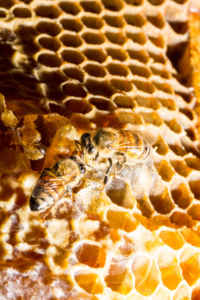
Interestingly, queen bees are fed royal jelly their whole lives. “The only difference between a queen bee and a worker bee is what they’re fed. Once the workers start getting fed pollen it changes gene expression and it changes their development,” Dr. Leavey explained. This difference in diet leads to distinct behavioral characteristics. For example, the bigger, fertile, longer-lived queen bees leave the hive to mate, unlike the smaller, sterile worker bees.
In the hive are also the bees’ pollen stores, known as “bee bread.” Bee bread is fermented flower pollen and is the primary source of protein for the hive. Forager bees collect the pollen from flowers and groom it off of their body into “pollen baskets” on their hind legs. “They do add a little bit of nectar to the pollen to make it this dough-ball of pollen that they carry,” Dr. Leavey explained. This pollen load is then carried back to the hive and packed into comb cells for storage. The bees add nectar, honey, and saliva to the pollen when they pack it. “You can kind of smell it when you open a hive. It has that yeasty smell. There are microbes that mix with the pollen and ferment it a little bit and that’s what they use to feed the larvae,” Dr. Leavey says.
SAVE THE BEES
While the complexities of a honey bee colony allow it to thrive, these complexities also make it easy to disrupt. “It’s very hard to keep bees now,” Dr. Leavey says. “There are three contributors to colony collapse. It’s pesticide exposure, disease, and poor nutrition.” The latter results from a lack of habitat and appropriate floral resources for the bees.
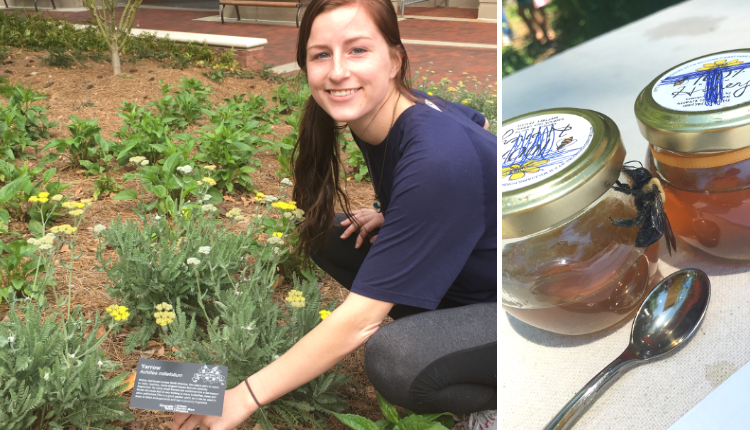
Help support bees by planting bee-friendly flowers and trees
To help support the bee population, Dr. Leavey suggests planting flowers that are easy to look at, like sunflowers, which a lot of bee species visit. She also recommends reading lists of region-specific pollinator-friendly plant species published by the Xerces Society and planting trees, specifically tulip poplar trees in Atlanta. “I think trees are great just because one tree has so many flowers,” she says.
The Urban Honey Bee Project is committed to supporting these pollinators and the environments that they need to thrive through a wide range of research and outreach efforts to help local community partners establish their own beehives. To keep up with the Urban Honey Bee Project, checking in on the bees via the “bee-cam” or getting involved as a volunteer, visit their website. You can also follow them on Facebook for more updates.
Thank you to Jennifer Leavey and everyone at Georgia Tech Urban Honey Bee Project for teaching us about the awesome science of honey production. Follow Science ATL on Facebook, Twitter, and Instagram for more Awesome Science of Everyday Life features and other science updates!
